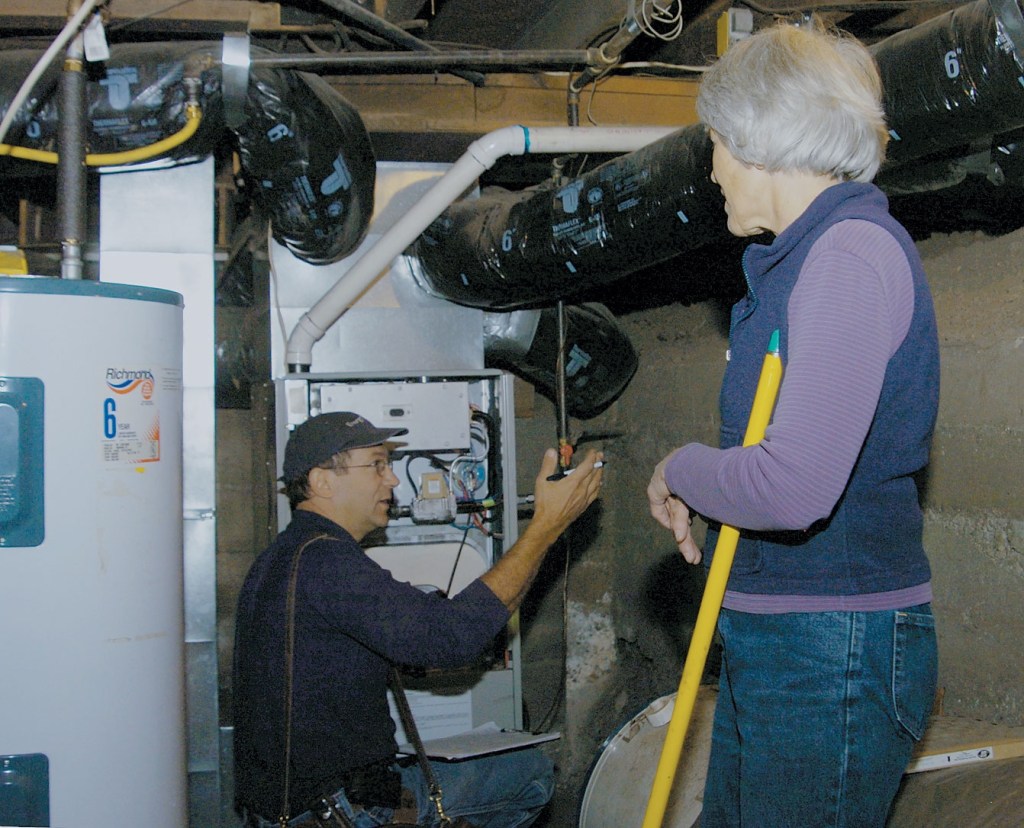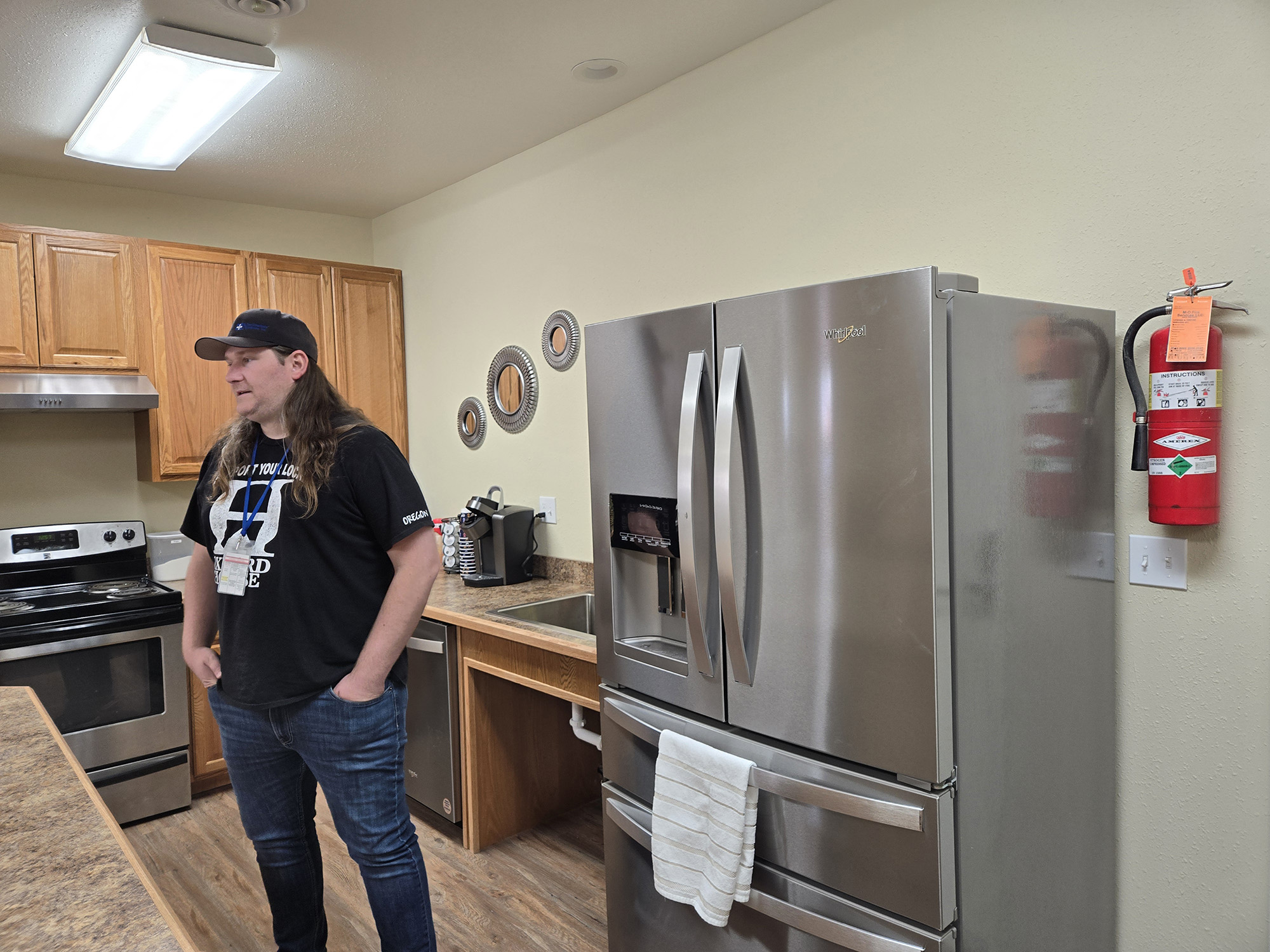Sleuth seeks to slash home heating bills
Published 5:30 pm Wednesday, October 19, 2011

- Mary Sue Rightmire, right, of Baker City, listens as Dave Felley of Energy Trust of Oregon suggests ways she can make her natural gas furnace run more efficiently â and cheaply.
By JAYSON JACOBY
jjacoby@bakercityherald.com
Dave Felley is creeping around Mary Sue Rightmire’s basement, peering into nooks, shining his tiny flashlight into crannies, and looking like nothing so much as a detective.
Which he is, basically.
Except Felley doesn’t carry a badge, and he isn’t looking for evidence of a crime.
Unless you consider wasting energy a crime, that is.
Rightmire invited Felley on Tuesday afternoon to scrutinize her Baker City home, from basement to attic, and tell her what’s wrong with it.
Specifically, to tell her how she can use less natural gas to heat her
110-year-old two-story home, which, like many similar structures in
this history-loving city, was built long before the concept of R-value
had been conceived.
(Or using natural gas as a heat source, come to that. As proof,
skulking in a corner of Rightmire’s basement is a hulking iron vat –
the coal-burning furnace that was the home’s original source of warmth.)
Felley works for Energy Trust of Oregon.
That’s an independent, nonprofit outfit that strives to help homeowners such as Rightmire slash their energy bills.
Money to operate Energy Trust comes from a surcharge added to bills for
customers of the four major investor-owned utilities with customers in
Oregon: Cascade Natural Gas (Baker City’s supplier), Northwest Natural
Gas, Pacific Power and Portland General Electric.
Felley, who works out of La Grande, conducted a “home energy review” for Rightmire.
The process takes an hour or two.
Reviews are free for local residents whose primary heating source is natural gas.
To schedule a review, call 1-866-368-7878, or go to www.energytrust.org/start.
Oregon Trail Electric Cooperative has a similar program for homeowners
who heat with electricity. More information is available by calling
Shari Shermer at OTEC, 541-524-2850.
Felley said one of his primary goals during a home tour is to find air
leaks. The more leaks, the more gas (or electricity) a furnace has to
burn to keep your home warm.
He started his perusal of Rightmire’s home in the basement – the nerve
center, so to speak, since that’s where the gas furnace resides.
(Although Rightmire’s water heater is electric, Felley did recommend
that she check the temperature setting. Keeping the heater at 125
degrees – or 140 degrees if your dishwater doesn’t pre-heat water – can
save considerable energy.)
Felley quickly identifies a couple of problems.
He suggests Rightmire have her brick chimney sealed, since she replaced
her woodstove with a gas-burning fireplace earlier this year.
“The purpose of the chimney is to pull air out of the house,” Felley
said. “If all it does is pull warm air out of the house, that’s not
good.”
Then, while he’s poking around in the furnace, Felley notices that its air filter doesn’t fit quite right.
It looks to be about an inch too wide, which leaves a gap where air could leak and make the furnace run less efficiently.
Rightmire leans forward to look at the filter, pausing briefly to brush
cobwebs off Felley’s shoulder with a broom she brought downcellar for
just that purpose.
“That’s OK – cobwebs are part of the job,” Felley says with a chuckle.
While checking the foundation walls, he notices a slight glow amid the
gloom, rather like the dim point of light at the far end of a tunnel.
He shines his flashlight beam on a gap about two inches wide at the top of the foundation wall.
“I’ve never noticed that before,” Rightmire says.
Then she follows Felley up two flights of stairs to the second floor of her 1,200-square-foot home.
While investigating the attic, Felley takes a photo with his digital
camera. It shows a section of white, flexible duct – it looks like a
section of a clothes dryer vent – that juts up from the sea of pink
insulation like the stack of an old steamship.
The duct, which connects to the second floor bathroom, should vent outside the home, not directly into the attic, Felley says.
As it is, that vent is releasing lots of moist air into the attic, which likely turns into frost during the winter.
“That’s good to know,” Rightmire says. “I had no idea.”
The good news, Felley says, is that the attic is well-insulated.
Elsewhere on the second floor, Felley pokes his fingers in a gap where
the ceiling and the wall meet (and briefly gets one finger stuck).
He recommends Rightmire plug the crack with a flexible material – “it’s
kind of like a licorice whip,” he says – and then install moulding to
completely seal the gap.
“That’s going to give you a lot of benefit,” Felley says.
“I should be writing this stuff down,” Rightmire says.
“I’m writing it all down for you,” Felley replies.
In fact he enters all his findings in a laptop computer that’s
connected to a portable printer. The printer ejects a custom report for
Rightmire.
The report lists Felley’s recommended energy-saving tasks, as well as
Energy Trust rebates and incentives for which Rightmire might qualify.
Energy Trust will pay to seal and repair heating ducts, for instance.
The organization would also pay up to $275 to help Rightmire have insulation installed in her basement.
Felley said the results of his survey are typical for an older home such as Rightmire’s.
“Air leaks are almost always a big issue in an older home,” he said.
Homes built in the past 30 years or so generally are of much “tighter”
construction, he said, largely a function of more stringent building
codes and better materials.
However, Felley and Susan Badger-Jones, Energy Trust’s Northeast Oregon
Outreach Advisor who participated in the review of Rightmire’s home
Tuesday, said even some newer homes can benefit.
Although each home is unique, the Energy Trust officials said that in
some cases a homeowner can save as much as 60 percent on heating costs
(and cooling, in the case of air-conditioned homes) through a
combination of adding insulation, sealing air leaks, and replacing
older, inefficient furnaces and appliances.
Rightmire said she learned about Energy Trust’s services this July
during Miners Jubilee, where the organization had an information booth.
Energy Trust also has scheduled a free home energy IQ workshop Oct. 26
from 6 p.m. to 8 p.m. at the Baker County Library, 2400 Resort St.
Refreshments will be served.





